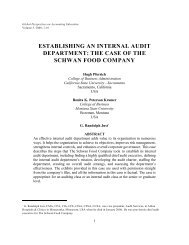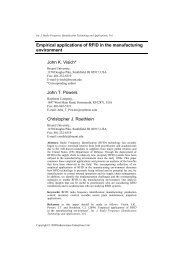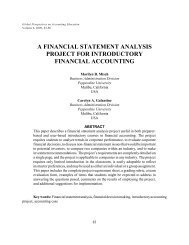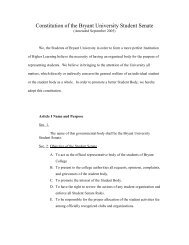Why use multiple-choice questions on accounting - Bryant
Why use multiple-choice questions on accounting - Bryant
Why use multiple-choice questions on accounting - Bryant
You also want an ePaper? Increase the reach of your titles
YUMPU automatically turns print PDFs into web optimized ePapers that Google loves.
<str<strong>on</strong>g>Why</str<strong>on</strong>g> Use Multiple Choice Questi<strong>on</strong>s 39The results for the gender variable were inc<strong>on</strong>clusive. Beca<str<strong>on</strong>g>use</str<strong>on</strong>g> the underlying dummyvariable was coded as “0” for males and “1” for females, the regressi<strong>on</strong> coefficient of “1.3,” ifsignificant, would imply that females have a str<strong>on</strong>g advantage over males <strong>on</strong> CR <str<strong>on</strong>g>questi<strong>on</strong>s</str<strong>on</strong>g>.However, the P value of .229 indicates that gender is not statistically significant. Beca<str<strong>on</strong>g>use</str<strong>on</strong>g> thec<strong>on</strong>clusi<strong>on</strong> of a str<strong>on</strong>g positive bias for females <strong>on</strong> MC tests is inc<strong>on</strong>sistent with earlier studies(Bible et al., 2008; Kuechler and Simkin, 2003; Gutek and Biks<strong>on</strong>, 1985), all of which found smallgender differentials favoring males <strong>on</strong> MC tests, we c<strong>on</strong>sider the n<strong>on</strong>-significant positive result forfemales an artifact of this particular data set. The lack of gender significance in fact reflects themeta-level inc<strong>on</strong>sistency found for gender effects in prior studies.Finally, we found that seven out of nine of the coefficients for our class (dummy) variableswere statistically significant. As noted earlier, this finding merely c<strong>on</strong>firms our asserti<strong>on</strong>s that amyriad of factors differed from test to test, and therefore, between classes and semesters–forexample, how hard each test was relative to the others.2Perhaps the most important statistic in our linear regressi<strong>on</strong> was the adjusted R value of“.301.” This finding is c<strong>on</strong>sistent with similar models tested by Kuechler and Simkin (2003), whofound a comparable value of “0.45” in a similar study of informati<strong>on</strong> systems students. The ultimateassessment of whether such a result is “good” or “bad” is subjective, but (for the reas<strong>on</strong>s explainedabove) we expected a higher value.Individual Class Regressi<strong>on</strong>sTo isolate the possible interactive effects of the differentiating factors ca<str<strong>on</strong>g>use</str<strong>on</strong>g>d by a differentset of tests and students, the authors also performed regressi<strong>on</strong>s for each class separately, using <strong>on</strong>lyan intercept, MC, and gender as explanatory variables. Table 6 reports our findings.As with the results in Table 4, most of the regressi<strong>on</strong> coefficients for these latter models werestatistically significant. However, the actual estimati<strong>on</strong> values differed from semester to semester,reflecting the differences in test <str<strong>on</strong>g>questi<strong>on</strong>s</str<strong>on</strong>g>, variati<strong>on</strong>s in teaching effectiveness, and different studentcompositi<strong>on</strong>s. Of particular interest were the coefficient estimates for the MC variable, which rangedin value from “.20” (for class 10) to “0.83” (for class 2). Again, the positive signs of these estimatesreinforce the intuitive noti<strong>on</strong> that student performance <strong>on</strong> MC and CR <str<strong>on</strong>g>questi<strong>on</strong>s</str<strong>on</strong>g> are related to <strong>on</strong>eanother, and again, n<strong>on</strong>e of these estimates were statistically differentiable from a desirablecoefficient value of “1.0”–the ideal value indicating that performances <strong>on</strong> MC and CR tests areperfectly synchr<strong>on</strong>ized.We note that the regressi<strong>on</strong>s for five of the ten classes taken individually have adjusted R 2values less than the summary regressi<strong>on</strong> c<strong>on</strong>taining all data points. We also note that “gender” wassignificant for <strong>on</strong>ly <strong>on</strong>e class (Class 2). Both of these observati<strong>on</strong>s lend credibility to the results of2the all-class regressi<strong>on</strong> (Table 4), which also reports a small R value and a n<strong>on</strong>-statisticallysignificantgender coefficient (p =.229).Two Additi<strong>on</strong>al Statistical TestsTo further examine the statistical properties of our sample data, we performed both amatched-pair test for the mean difference in scores and a Wilcox<strong>on</strong> signed rank test for each of the10 different classes in our sample. Again, we tested our class data separately in order to reduce thec<strong>on</strong>founding effects potentially inherent in combining the data from different class subjects, varyingamounts of course support, alternate instructors, and similar artifacts. Beca<str<strong>on</strong>g>use</str<strong>on</strong>g> we could not



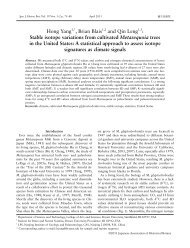
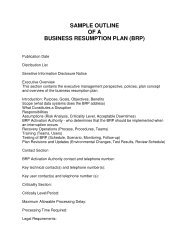
![[1] The Legal Environment of Business (LGLS211) Andrea Boggio ...](https://img.yumpu.com/45269009/1/190x245/1-the-legal-environment-of-business-lgls211-andrea-boggio-.jpg?quality=85)
